Description
The Sweetheart of the Fig Family
Belonging to the Fig Genus, the Ficus Tree is a very popular and appealing plant. With hundreds of species, the plant catches the attention of many. Nonetheless, very few can be found in cultivation. They are native to many regions of the tropics, mostly including America, Asia, and Africa.
Known by many names, some Ficus Trees are also referred to as fig trees, producing a well-known and enjoyable fruit.
Other common names are Ficus Benjamina (a variety of the plant) and weeping fig. Inside your home, the ficus can be a marvelous specimen plant that is abundant with lush foliage. However, to ensure that the plant thrives throughout the year, you must adhere to some specific care routines.
Caring for your Ficus Benjamina
People will often struggle when it comes to caring for the Weeping Ficus plant. These plants are not very resilient to cold conditions and respond to drafty conditions by shedding their leaves.
Not to mention, they do not fare well if you move them too much. Not only are they vulnerable to pests and infestation, but their tropical habitat means that you have to provide them with a particular environment if you wish to grow them indoors.
Light
The plant, in general, requires bright light; however, this does not mean that they will benefit if you place them under direct sunlight. The only plants that can withstand direct sunlight are the acclimated ones. You have to, therefore, make sure that they get high-intensity light, but not to the level of direct sunlight. Light is extra important for this plant to reduce leaf loss in its new home
Water
The watering requirement to keep the ficus tree indoors changes according to the seasons. For instance, in the winters, it requires less watering compared to the summers. Moreover, since the plant is from a tropical habitat, it requires plenty of moisture to thrive.
Therefore, if your indoor atmosphere is very dry, your plant may suffer. To keep the moisture levels high, you will have to resort to misting and watering to keep the plant healthy. Also, make sure to check the soil after you water the plant and make sure that the roots do not dry.
Soil and Fertilizer
A ficus needs very fertile and nutrient-rich soil. Along with that, it also requires good pot drainage. Make sure that you do not use potting soils that are too acidic, and use soil-based potting mixes.
When feeding your ficus, slow-release pellets can work well at the beginning of the growing season. They have a rapid growth rate, and this means that you can benefit from feeding them in spring and summer. This also implies that you can slow down the fertilization in the colder seasons.
Common Issues (Pests and Disease)
Apart from being vulnerable to mites, whiteflies, and other insects, they also respond poorly to even the slightest changes in the conditions. Any stress will result in the loss of leaves, which is why you have to be thorough and precise when caring for this plant.
Pruning
Pruning the ficus tree is important. It keeps the plant in shape and, in some cases, prevents it from outgrowing the indoor space.
It is best to prune this plant during the winter season. This is the time in which the plant is not actively growing. When pruning, cut a few inches from a node to maximize sprouting success.
Propagation
Air layering is the preferred propagation method for the ficus. In this method, you have to wrap the stem with damp moss to encourage root growth.
Potting / Repotting
When you provide a ficus plant with adequate conditions and a healthy environment, it will easily outgrow your house, let alone the pot.
Keep in mind that this plant, in its natural habitat, is a surface tree. Repotting every other year can help slow the plant’s growth and keep it at a size that you can manage.

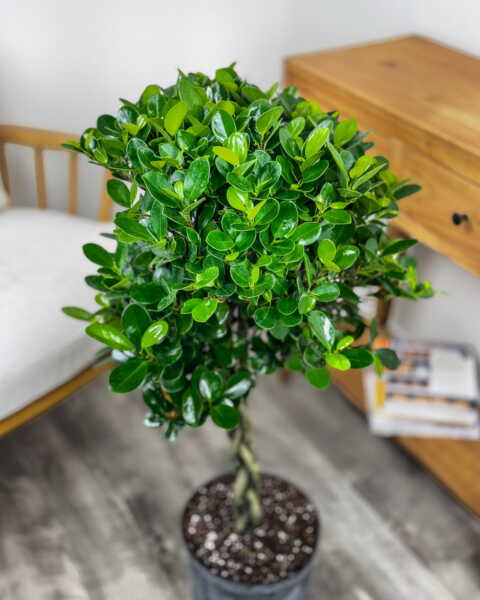

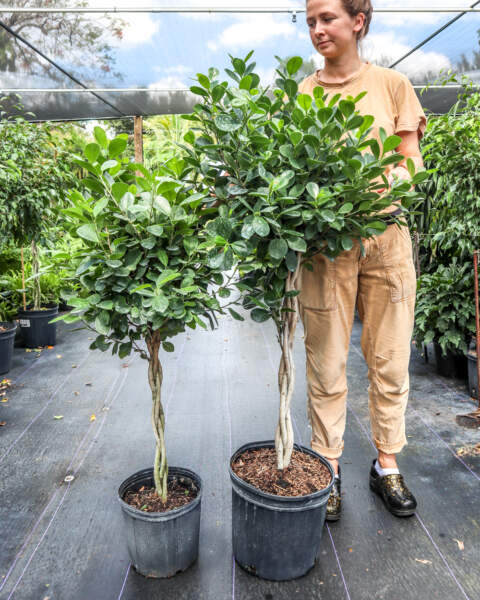
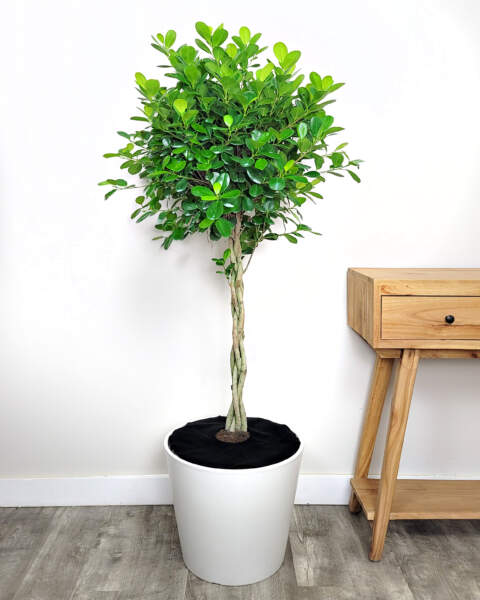
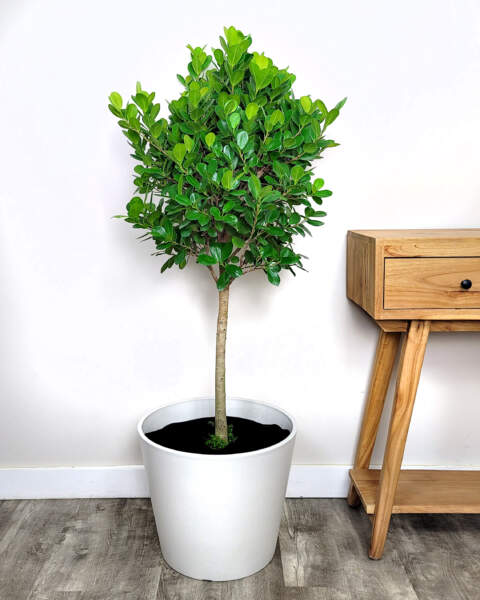
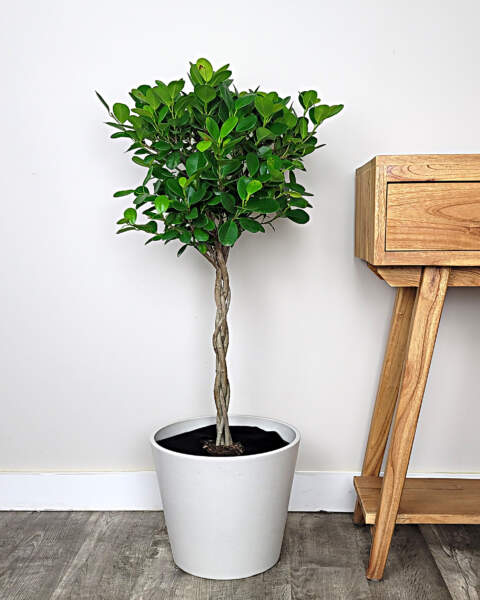














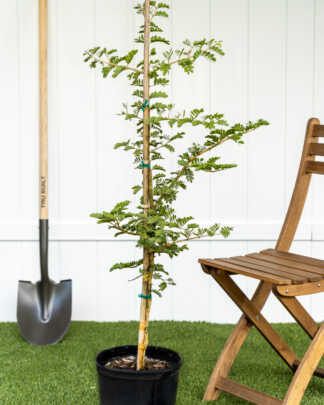
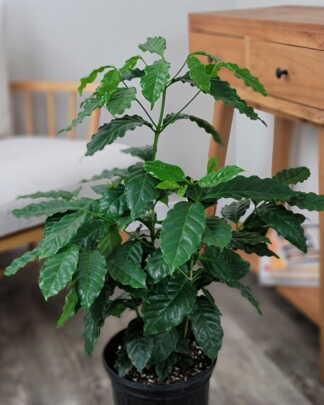
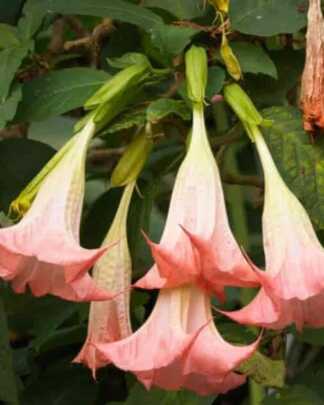

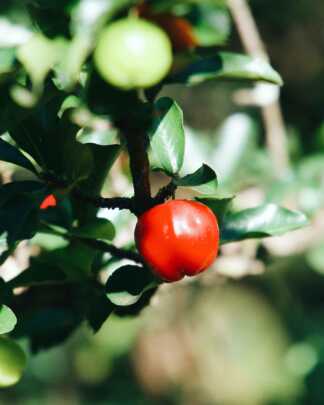







Anonymous (verified owner) –
William (verified owner) –
Neatly trimmed and well cared for.
Shan (verified owner) –
Pros:
– Plant arrived healthy and as described, not many leaves died during shipping. I ordered the “Large” and the pot size was a bit over 9 inches wide, tree was 3ft tall (measuring from the top of the soil) and foliage is 1.5ft wide.
– Plant was shipped very securely. Packaging was great. Even though the package was on its side on my porch there was no damage and the dirt stayed in place.
Cons:
– THE BIGGEST ISSUE: The tree was planted too deep in its pot. I removed almost 2 inches of soil from the top of the pot. This is a problem because there are no roots in the extra soil so it is effectively mulching your indoor plant, keeping the soil more moist than what is appreciated. Before removing the soil, the leaves continued to yellow and fall off even 2-3 weeks after the shipping stress (which seemed minimal). After I removed the extra soil on top, the soil dries out much better and the plant is now happy and producing new leaves.
– It took 11 days from my order being placed to the plant being shipped out (no weather issues)
– The plant is potted with its trunk leaning in one direction. I chose not to re-pot my plant and use a cache pot instead so I can’t fix the lean without stressing it unnecessarily.
– The photos are somewhat misleading as the angle is from the top down. I expected my plant’s foliage to be bigger and bushier based on the photo I received during shipping.
Overall it was still a good purchase and would recommend if you don’t have any local options but next time I will probably just be patient until my local nurseries receives a specific plant.
Rosario (verified owner) –
Great service, fast shipping, quick response to questions. I love they sent me a picture of the tree before shipping
Talaat Aggour (verified owner) –
The team at Plantvine has always been helpful and that is my experience in dealing with them for many years and talking to the many sales associates I have dealt with over the years
Patricia Stimers (verified owner) –
very happy. Its healthy and not even dropping leaves of far!
Carol (verified owner) –
Very healthy plant. I know height was in the description, but still was much smaller than I expected!
Charlotte (verified owner) –
It’s in great shape, I did have to wipe down every leaf as they were all dirty. I also had to go through the top soil as there were tons of millipedes there. But it looks like it’s thriving so far.
Anonymous (verified owner) –
The tree got delivered in a great condition
Cherynne M. (verified owner) –
healthy and beautiful – waited months before the weather was good enough to ship and no regrets.
Taryl B. (verified owner) –
Shelly (verified owner) –
Not quite as full as I’d hoped but a healthy ficus.
Karen A. (verified owner) –
Plants were packaged well….no breakage, leaves dropping and soil was still wet. They look healthy and attractive.
Carol –
Is this an indoor or outdoor tree? Can it be grown indoors?
Carol –
When do you recommend repotting?
Kimberly-Ann M. (verified owner) –
This little tree has a beautiful, round shape and arrived in perfect condition. Shipping was very quick, too! I ordered the x-large braided and I’m thrilled with it.
Kimberly-Ann McKean (verified owner) –
It’s beautiful! Arrived in perfect condition just 4 days from my order date. I bought the XL braided and the shape is absolutely gorgeous. I’m in love!
Patrick Riley –
Hi what size is the nursery pot it is shipped in. What size pot should I repot it in?
JAMES MCNULTY –
What is the width and height of the braided large vs the braided extra-large?
Jessica B. (verified owner) –
Such a good purchase. Loving the quality! Even came sooner than the tracking said it would.
Cathy Lance (verified owner) –
Smaller than I thought, but absolutely beautiful.
Frederick (verified owner) –
Megan –
Hi – If you select “extra large tree” does that mean it’s a single stem vs braided? I would prefer one not braided.
Anonymous (verified owner) –
Melissa W. (verified owner) –
Arrived in excellent condition
Shelley D Boston (verified owner) –
Vicki S. (verified owner) –
The plant arrived in excellent condition. It looks gorgeous in my piano room. I hope it likes it’s new home as much as we like it! Fingers crossed!
Ayesha Brew –
Hi, what’s the measurements for the large braided?
Whitney C. (verified owner) –
I ordered this to brighten up a bare corner in our living room. It took a little while to arrive, which I expected since I ordered it during the Stay at Home order. It arrived nicely packaged and in tact. I have only had it for a 3 days now but it seems to be doing well! I do suggest you measure your space for the size because it was smaller than I anticipated which is totally my fault! Luckily I had a plant stand on hand to get it to the height I wanted. I never knew a plant would make such a difference in a room!
Lisa (verified owner) –
Surpassed expectations. Thank you!